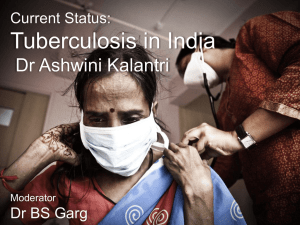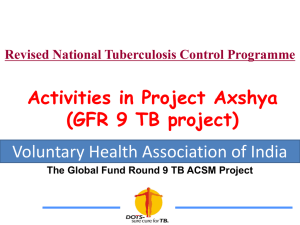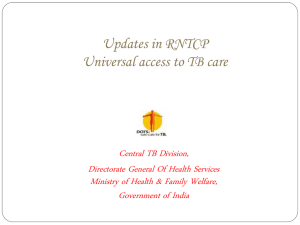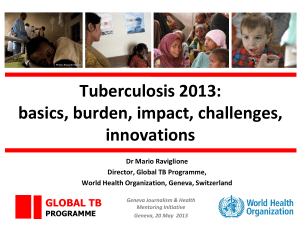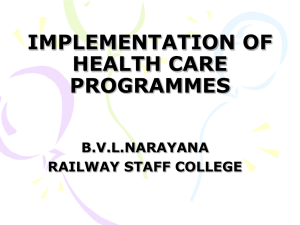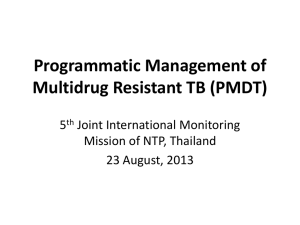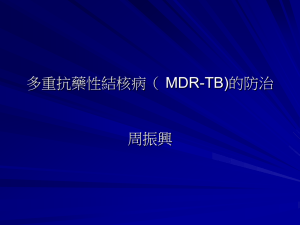Status of RNTCP in India
advertisement
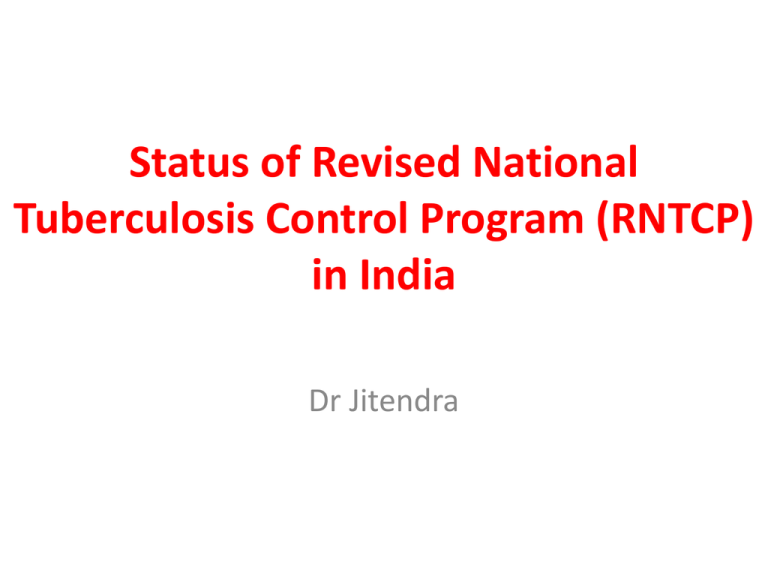
Status of Revised National Tuberculosis Control Program (RNTCP) in India Dr Jitendra Framework • • • • • • • • • TB burden RNTCP implementation RNTCP performance Achievements Under RNTCP - Case Detection Rate - Cure Rate Progress Towards MDGs Cost Effectiveness of Program RNTCP- DOTS-Plus Changes in RNTCP policy Challenges Estimated epidemiological burden of TB Global India Annual incidence 9.3 of TB (million) 1.9 HIV + among TB 5% 15% India is Highest TB Burden Country India is 17th among 22 High Burden Countries (in terms of TB incidence rate) National ARTI- 75 NSP PTB cases/100,000 population Source: WHO Report 2008: Global Tuberculosis Control; Surveillance, Planning and Financing Revised National TB Control Program (RNTCP) • Launched in 1997 based on WHO DOTS Strategy – Entire country covered in March’06 Largest & fastest (632 districts/reporting units) expanding program • Implemented as 100% centrally sponsored program – GoI is committed to continue support till TB ceases to be a public health problem in country RNTCP… All components of STOP TB Strategy-2006 are being implemented 1. Pursuing high-quality DOTS expansion and enhancement 2. Addressing TB/HIV, MDR-TB and other challenges 3. Contributing to health system strengthening 4. Engaging all health providers 5. Empowering people with TB, and communities 6. Enabling and promoting research RNTCP performance- 2009 Continue to achieve twin objectives of NSP case detection and cure rate at the national level New Sputum Positive Case Detection Rate ≥ 70% Cure rate≥ 85% RNTCP performance… Suspects Examined/ lakh pop Annualized new sm+ CDR (%) Cure rate of new Sm+ pt T/t success rate of new Sm+ pt India 154 59(78) 85% 87% MH 137 48(60) 83% 85% WR 147 40(50) 67% 82% Achievements Under RNTCP TB Suspects Examined per 100,000 Population(2000-2009) Achievements … Case Detection Rate and Treatment Success Rate CDR- 72% 78% Treatment success rate- 85% 87% Achievements in line with the global targets Annualized new smear (+) case detection rate and T/t success rate Achievements since implementation > 40 million TB suspects examined > 9 million patients placed on treatment > 1.6 million lives saved (deaths averted) Progress Towards MDGs Goal 6: “Combat HIV/AIDS, malaria and other diseases” - Target 8: “By 2015, to have halted and begun to reverse the incidence of malaria and other major diseases…” • Indicator 23: between 1990 & 2015 to halve prevalence of TB disease and deaths due to TB 47% • 33% ? ? Indicator 24: to detect 70% of new infectious cases and to successfully treat 85% of detected sputum positive patients Global (2006) India NSP CDR 61% 70% (2007 onwards) T/t success rate 85% 85% (2003 onwards) WHO Global TB Report 2008 Cost Effectiveness of Program in India • Total cost of TB control per capita is US $ 0.1 (2007) • Cost of first line drugs per patient treated in India is US $ 14 compared to US $ 30 (median) for High Burden Countries (HBCs) • India remains the country with lowest cost per patient treated (US $ 84) compared to US $ 274 (median) for HBCs Source: WHO Report 2008, Global Tuberculosis Control; pg 71 &112 RNTCP- DOTS-Plus • RNTCP regimens highly effective, with low failure rates (2% in CAT I , 6% in CAT II cases) India- Highest burden country in world On verge of MDR-TB epidemic MDR-TB: 3% in new cases 12-17% in retreatment cases • Failure cases- previously not been well addressed by RNTCP, now have been addressed in RNTCP under DOTS-Plus DOTS-Plus… Strategy to prevent MDR-TB 1. Through sustained high-quality DOTS implementation (DOTSPlus) - MH and GJ: 2007 - AP, DL, HR, KE and WB: 2008 - Remaining states: 2009-2010 2. Improve lab capacity- 27 Accredited culture and DST IRLs are being established across country in a phased manner 3. Effective t/t of MDR-TB DOTS-Plus in MH: Nagpur circle- 7district (2007) Akola circle- 6 district (2008) 100% coverage across MH state by 2012 RNTCP- DOTS-Plus Vision • By 2010 DOTS-Plus services available in all states • By 2012, universal access under RNTCP to laboratory based quality assured MDR-TB diagnosis for all retreatment TB cases and new cases who have failed treatment • By 2012, free and quality assured treatment to all MDR-TB cases diagnosed under RNTCP (~30,000 annually) • By 2015, universal access to MDR diagnosis and treatment for all smear positive TB cases under RNTCP Changes in RNTCP policy on diagnosis of smear positive pulmonary TB 1. Number of sputum specimen required for diagnosis is 2, with one of them being a morning sputum 2. Diagnosis of PTB suspect- One smear specimen positive out of the two is enough to declare a patient as Sm+ PTB 3. Definition of PTB suspect- any person with cough for 2 weeks, or more Challenges… • Wide variation in capacity of health systems in states • Burden due to TB-HIV co-infection • Ensure adherence of treatment • Large & unregulated private system References • Global tuberculosis control : epidemiology, strategy, financing : WHO report 2009. • TB INDIA 2009. RNTCP Status Report. Central TB Division. Directorate General of Health Services. Ministry of Health and Family Welfare. New Delhi. • RNTCP Performance Report, India. Second Quarter, 2009. Central TB Division. Directorate General of Health Services. Ministry of Health and Family Welfare. New Delhi. • RNTCP Performance Report, India. Second Quarter, 2008. Central TB Division. Directorate General of Health Services. Ministry of Health and Family Welfare. New Delhi. • Global Tuberculosis Control: Surveillance, Planning and Financing: WHO Report 2008. • TBC India. Directorate General of Health Services. Ministry of Health and Family Welfare. New Delhi. [Online]. 2009. [cited 2009 Dec 7]; Available from: URL: http://www.tbcindia.org. THANK YOU
